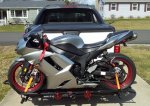Well, the carrier you pictured is described as being good for dirtbikes up to 400 pounds in weight. Maybe you want the sportbike carrier instead?
An R1 is what, 425 to 450 pounds with some fuel load still in it? The carrier itself weighs about 75 pounds. That puts you right at or above the upper limit of a Class 3 hitch which is probably the most you have on your minivan.
Class 3 hitch is good for 500 pounds tongue loading on a standard receiver draw bar. The bike carrier is different though. It puts the weigh a bit further out than a standard draw bar, and that has the effect of putting a heavier lever on your hitch receiver. Your hitch receiver should be engineered to have some safety margin, but....
Also, unlike a standard draw bar which encounters mostly vertical loading and a little bit of horizontal loading, that bike carrier is going to add more vertical loading accompanied by potential rotational loading as your bike rocks on the axis of the hitch receiver. The rough the road, the greater the bad effects of both vertical and rotational loading on a hitch carrier that is already at or over the load limit for your receiver.
On top of that, you're slinging all that bike and carrier weight at the very rear of your vehicle, a vehicle that will probably also be loaded up back there with the family and stuff you're taking with you on your trip. Can your minivan take the load on the rear suspension? What will it do for your minivan handling?
A small trailer will add a bit of extra weight over and above that of a hitch carrier but it will be drawn weight and not carried weight. The tongue loading on your minivan's rear suspension will be only 100 or 125 pounds compared to 500+ pounds with the hitch carrier. You'll find that a small trailer will make for a much more pleasant drive.
















